
Shortsville, officially the Village of Shortsville, is a village in Ontario County, New York, United States. The population was 1,439 at the time of the 2010 U.S. Census. Shortsville encompasses the southwestern part of the Town of Manchester and is located north of the City of Canandaigua.

The Roman Catholic Diocese of Clifton is a Roman Catholic diocese centred at the Cathedral Church of Saints Peter and Paul in Clifton, England.

St. John's Episcopal Church, Lafayette Square is a historic Episcopal church located at Sixteenth Street and H Street NW, in Washington, D.C., along Black Lives Matter Plaza. The Greek Revival building, designed by Benjamin Henry Latrobe, is adjacent to Lafayette Square, one block from the White House. It is often called the "Church of the Presidents".

The Diocese of Bristol is an ecclesiastical jurisdiction or diocese of the Church of England in the Province of Canterbury, England. It is based in the city of Bristol and covers South Gloucestershire and parts of north Wiltshire, as far east as Swindon. The diocese is headed by the Bishop of Bristol and the Episcopal seat is located at the Cathedral Church of the Holy and Undivided Trinity, commonly known as Bristol Cathedral.

St. Michael's Church is a historic Episcopal church at 225 West 99th Street and Amsterdam Avenue on Manhattan's Upper West Side in New York City. The parish was founded on the present site in January 1807, at that time in the rural Bloomingdale District. The present limestone Romanesque building, the third on the site, was built in 1890–91 to designs by Robert W. Gibson and added to the National Register of Historic Places in 1996.
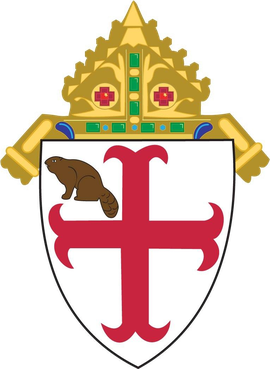
The Episcopal Diocese of Albany is a diocese of the Episcopal Church covering 19 counties in northeastern New York state. It was created in 1868 from a division of the Episcopal Diocese of New York.

William Stang was a German-born American prelate of the Roman Catholic Church. He served as the first bishop of the Diocese of Fall River in Massachusetts from 1904 until his death in 1907.

Christ Church — known also as Christ Church, Washington Parish or Christ Church on Capitol Hill — is a historic Episcopal church located at 620 G Street SE in Washington, D.C., USA. The church is also called Christ Church, Navy Yard, because of its proximity to the Washington Navy Yard and the nearby U.S. Marine Barracks.

The Episcopal Diocese of Southern Ohio is the diocese of the Episcopal Church in the United States of America with jurisdiction over 40 counties in southern Ohio. It is one of 15 dioceses that make up the Province of the Midwest. The offices of the Bishop of Southern Ohio and the cathedral, Christ Church Cathedral, are both located in downtown Cincinnati.

The Episcopal Diocese of Rochester is the diocese of the Episcopal Church in the United States of America with jurisdiction over eight counties in west central New York. It is bounded on the north by Lake Ontario, on the east by the Episcopal Diocese of Central New York, on the south by the Episcopal Diocese of Central Pennsylvania and on the west by the Episcopal Diocese of Western New York. It is in Province 2 and has no cathedral. Its diocesan offices are in Henrietta, New York.
St. John's Episcopal Church is a historic Episcopal church located at Phelps in Ontario County, New York. It was built in 1849, the chancel was extended in 1897, and the tower added in 1905. The meeting room and office addition was completed in 1954. It is architecturally significant as a Gothic Revival-style church that reflects the "English parish" movement traceable to the Church of St. James the Less in Philadelphia.
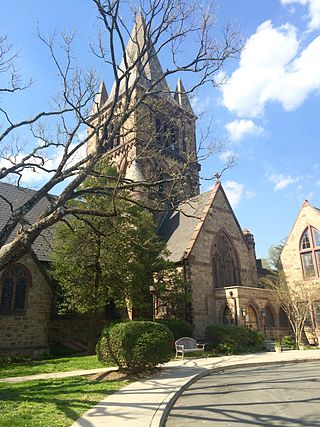
Trinity Church is a historic Episcopal congregation located at 33 Mercer Street in Princeton, New Jersey. It is the largest Episcopal church in New Jersey.
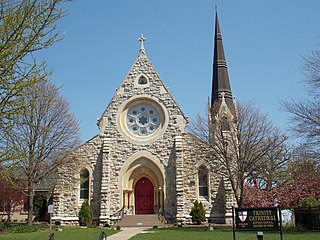
Trinity Episcopal Cathedral, formerly known as Grace Cathedral, is the historic cathedral in the Diocese of Iowa. The cathedral is located on the bluff overlooking Downtown Davenport, Iowa, United States. Completed in 1873, Trinity is one of the oldest cathedrals in the Episcopal Church in the United States. It was individually listed on the National Register of Historic Places in 1974. In 1983 the cathedral was included as a contributing property in the College Square Historic District, which is also listed on the National Register.

The former St. Paul's Episcopal Church is a historic church in Cleveland, Ohio, United States. Built for an Episcopal parish by a well-known architect, it became a prominent component of the city's wealthy Millionaire's Row, due to its grand architecture. Although vacated by its original owners in the 1920s, it was soon bought by a Catholic monastic group that occupies it into the present day. It was named a historic site in 1980.

Trinity Episcopal Church is a parish church in the Diocese of Iowa. The church is located in Muscatine, Iowa, United States. It was individually listed on the National Register of Historic Places in 1974. In 2006 it was included as a contributing property in the Downtown Commercial Historic District.

Margaret Isobel Chilton (1875–1963), born at Clifton, Bristol, was a British stained glass artist and instructor.
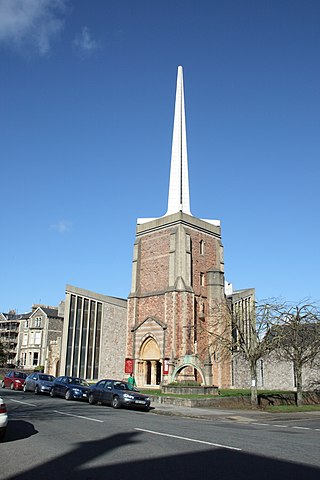
The Church of All Saints is a Church of England parish church in Clifton, Bristol. The church is a grade II listed building. It is located in the Parish of All Saints with St. John Clifton in the Diocese of Bristol.
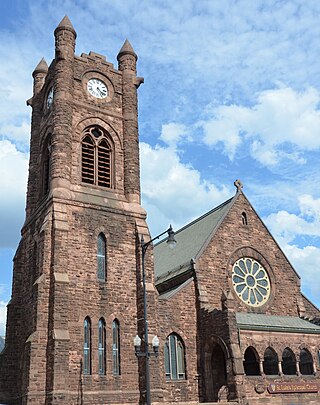
St. Luke’s Episcopal Church is a parish church in the Episcopal Diocese of Western New York. located at 410 North Main Street in Downtown Jamestown, New York. It is included on the National Register of Historic Places
Medina sandstone is a geographic subset of the Medina Group stratigraphic formation in New York state and beyond. The name refers specifically to sandstone first quarried in Medina, NY and later quarried in other locations in Orleans County and adjacent quarries in Monroe County to the east and Niagara County to the west. Medina sandstone was widely used to pave the streets of early U.S. cities because it was sufficiently hard to stand long and severe service, and in wearing, it maintained a flat, even surface where granite would wear round and acquire a smooth slippery polish. The Medina stone was also a highly desirable building stone that could be obtained in colors from light gray to pink, red and brown. It was used in the construction of hundreds of homes, churches, public buildings, monuments and other structures from the 1830s to the mid-1900s.

















